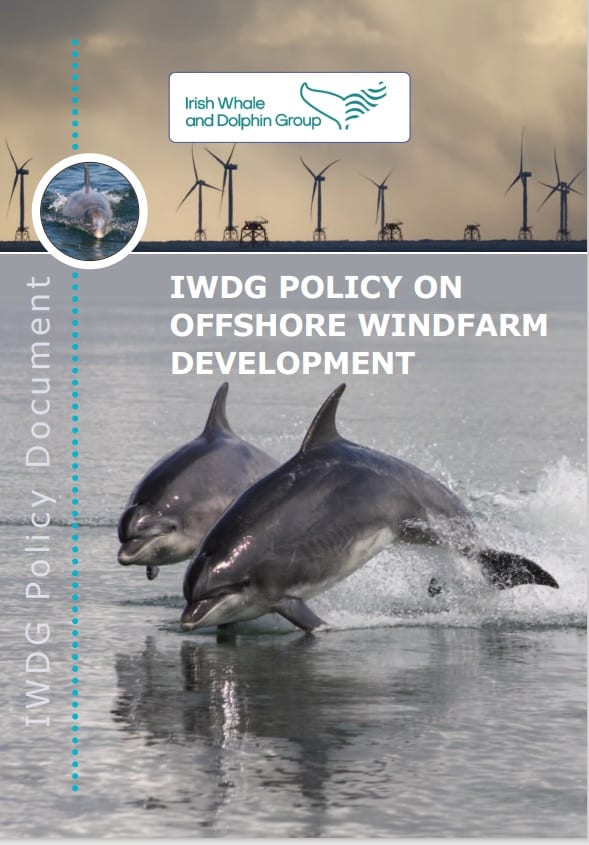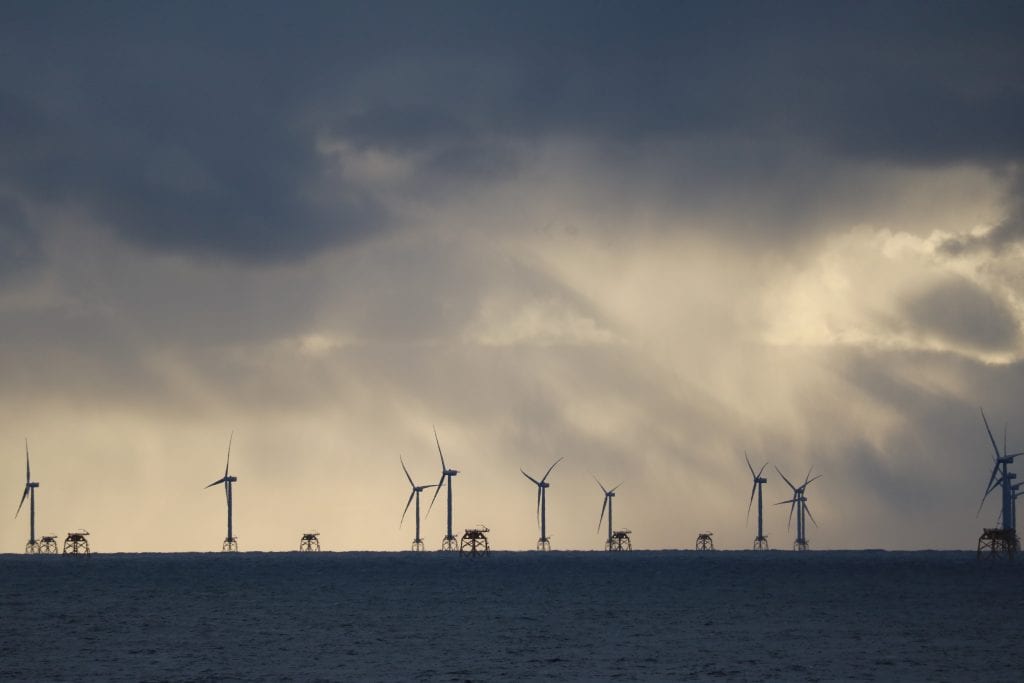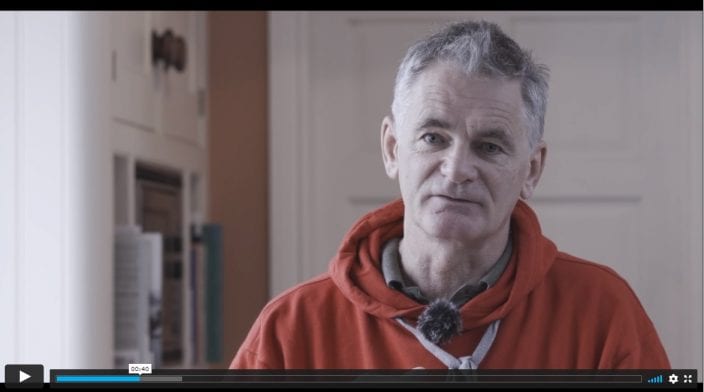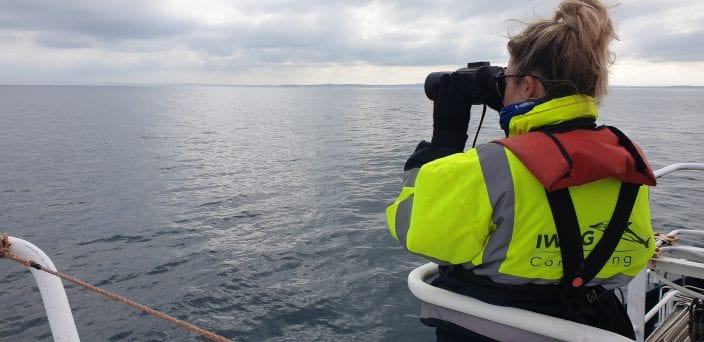Tá borradh faoi thionscal an fhuinnimh in-athnuaite mhara tuartha sna blianta amach romhainn agus sprioctháirgeadh de 5GW d’fhuinnimh gaoithe amach ón gcósta faoi 2030 agus 30 GW faoi 2050. Tacaíonn Grúpa Faire na Míolta Móra agus na nDeilfeanna (IWDG) le dícharbónú gheilleagar na hÉireann, ach é sin ráite, ba cheart go ndéanfaí aon fhorbairt amach ón gcósta taobh istigh den chreat náisiúnta agus idirnáisiúnta maidir le dea-chleachtas agus níor cheart go mbeadh ach tionchar fíorbheag neamhshuntasach aici ar mhíolta móra, deilfeanna agus muca mara agus ar a ngnáthóga.
Seoladh Doiciméad Beartais an IWDG maidir le Feirmeacha Gaoithe amach ón gcósta inniu ag an gcruinniú bliantúil WhaleTales. Tá sé mar aidhm ag an doiciméad beartais sin cur síos a dhéanamh ar an dea-chleachtas maidir le cosaint míolta móra, deilfeanna agus muc mara le linn an phróisis forbartha i dtaca le feirmeacha gaoithe amach ón gcósta. D’fhéadfai cuid mhaith de na beartais chéanna a chur i bhfeidhm ar aon suiteáil fuinnimh in-athnuaite mhara.
Duirt an príomhúdar Patrick Lyne ag an gcruinniú fíorúil “We have looked at recent research and international best practice to inform this policy document, and present a series of recommendations to try and help guide offshore windfarm development over the coming years. The aim is to mitigate or reduce our impact and to measure our impact such that future developments can be better planned, and existing ones perhaps improved”.
Déanann Patrick Lyne, príomhúdar dhoiciméad beartais an IWDG cur síos ar an ábhar atá ann.
Sa doiciméad, tá aird tarraingthe ag an IWDG ar an ngá le limistéir atá aitheanta mar láithreacha tábhachtacha i gcomhair míolta móra agus deilfeanna a chosaint, agus tá iarrtha ann athruithe a dhéanamh sna cleachtais mhaolaithe chun Aistriú Tairsí Sealadach (ATS) a chosc ionas go ndéileáiltear leis mar ghortú chomh maith. Tá sé iarrtha sa doiciméad, freisin, go mbainfí úsáid as Monatóireacht Fuaime Éighníomhach (MFÉ) mar uirlis mhaolaithe. Ó tharla go gcaitheann beagnach gach cineál céiticeach roinnt mhaith ama faoi uisce, is í an MFÉ an t-aon slí éifeachtach chun iad a bhrath agus ba cheart go gcuimseofaí é mar chuid de straitéis mhaolaithe 24 uaire.
Rinneadh iniúchadh ar nósanna imeachta mar thosuithe boga de réir an dea-chleachtais sa tionscal. Ba cheart athbhreithniú a dhéanamh ar úsáid na Feiste Fuaimchiaptha de réir na speiceas a bhíonn i láthair agus de réir pharaiméadair bheachta na feiste a úsáidtear, ionas go bhfeidhmíonn sí mar fheiste fuaimchiaptha éifeachtach sula gcuirtear tús leis na hoibríochtaí nuair is gá.
Suirbhé suímh feilme gaoithe amach ón gcósta á dhéanamh ag IWDG Consulting © Simon Berrow
Dúirt Príomhfheidmeannach an IWDG an Dr. Simon Berrow ” the amount of contact the IWDG have had with offshore windfarm companies in recent months is huge and we felt it was important to publish our thoughts about the development of this industry and its potential impacts on whales and dolphins. We are worried the state agencies involved in assessing planning applications and awarding licenses could be overwhelmed in the near future leading to bad decisions and delays”.
Sa doiciméad tá sé molta ag an IWDG go ndéanfadh comhlacht amháin comhordú ar na nósanna maolaithe go léir agus ar mheasúnú na riachtanas, ionas nach mbeadh difríochtaí i gcur i bhfeidhm ag na rialaitheoirí éagsúla agus go dtabharfaí na treoirlínte suas chun dáta anois de réir na ndea-chleachtas idirnáisiúnta.
Dúirt Stiúrthóir Oibríochtaí agus Tionscadal Éireann de chuid Simply Blue Energy, an Dr. Val Cummins “at Simply Blue Energy, we believe in doing the right thing for our stakeholders, the community and the environment. The IWDG Offshore Wind Policy is an extremely valuable document for us as a floating offshore wind developer seeking to implement best practice in the protection of cetaceans from the earliest stage of offshore wind development. We note the recommendations and support the need for a robust and effective regulatory system”.
Tá an doiciméad iomlán ar fáil anseo:
Doiciméad faoi Bheartas an IWDG maidir le Feirmeacha Gaoithe amach ón gcósta
The marine renewable energy industry in Ireland is set for explosive growth in the coming years with a production target of 5GW of offshore wind energy by 2030 and an ambition of 30GW by 2050. The Irish Whale and Dolphin Group (IWDG) supports the decarbonizing of the Irish economy, but offshore developments should be carried out within the framework of both national and international best practice and should have only minimal and not significant impacts on whales, dolphins and porpoises and their habitats.
An IWDG Policy Document on Offshore Windfarms was launched today at the group’s annual meeting WhaleTales. This policy document seeks to describe best practice in the protection of whales, dolphins and porpoises during the development process for offshore windfarms. Many of the same policies can apply to any marine renewable energy installation.
Senior author Patrick Lyne said at the virtual meeting “We have looked at recent research and international best practice to inform this policy document, and present a series of recommendations to try and help guide offshore windfarm development over the coming years. The aim is to mitigate or reduce our impact and to measure our impact such that future developments can be better planned, and existing ones perhaps improved”.
In the document the IWDG have highlighted the need to protect areas identified as being important for whales and dolphins and has called for changes to mitigation practices to prevent Temporary Threshold Shift (TTS) such that this is also treated as an injury. The document also seeks to promote the use of Passive Acoustic Monitoring as a mitigation tool. As nearly all cetacean species spend a considerable amount of time underwater, PAM is the only effective way to detect them and should form part of a 24 hour mitigation strategy.
Procedures such as soft starts were examined in line with industry best practice. Acoustic Deterrent Device use should be reviewed according to species present and exact parameters of the device used, in order that it acts as an effective deterrent prior to operations when necessary.
CEO of the IWDG Dr Simon Berrow said “the amount of contact the IWDG have had with offshore windfarm companies in recent months is huge and we felt it was important to publish our thoughts about the development of this industry and its potential impacts on whales and dolphins. We are worried the state agencies involved in assessing planning applications and awarding licenses could be overwhelmed in the near future leading to bad decisions and delays”.
In the document the IWDG recommends that all mitigation procedures and the assessment of requirements should be coordinated by a single body to avoid differences in implementation by different regulators and that the current guidelines be now updated in line with best practice internationally.
Operations and Projects Director Ireland for Simply Blue Energy Dr. Val Cummins, said “at Simply Blue Energy, we believe in doing the right thing for our stakeholders, the community and the environment. The IWDG Offshore Wind Policy is an extremely valuable document for us as a floating offshore wind developer seeking to implement best practice in the protection of cetaceans from the earliest stage of offshore wind development. We note the recommendations and support the need for a robust and effective regulatory system”.
The full document is available here:




